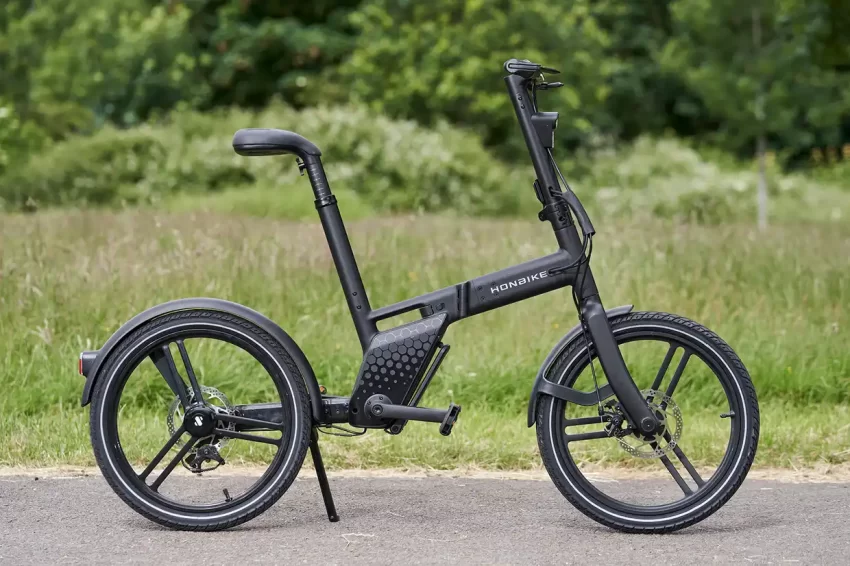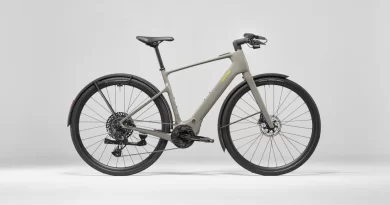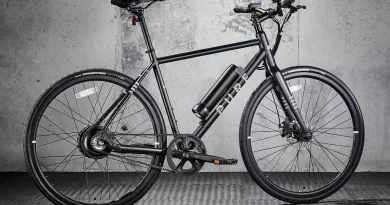HonBike One review
The headline design feature of the HonBike One is the omission of any chain or belt drive. Instead, this cleverly designed folding electric bike uses a shaft encased in a single-sided aluminium rear spar to the back wheel.
This shaft is geared at both ends, transferring the energy from your pedalling action to drive the rear wheel. Complementing this is a 250W front-hub motor driven by a pocket-sized 216Wh battery that’s housed centrally above the chainset.
The battery can be charged in situ, or you can eject the 18×9.5x6cm battery and charge it using the similarly compact 12.5×4.5×3.5cm charger.
The bike, which costs £1500.00, delivers five power levels that you access using a bar-mounted remote control that’s neatly integrated into the stem. The black-and-white LCD screen shows current power level, trip distance, speed, light status and remaining battery charge. It’s very well done and easy to use.
The drive shaft is enclosed completely and HonBike claims it will run maintenance-free for more than 40,000km. It’s smooth and silent, and there was no lag when I pressed down on the pedals and the rear wheel was being driven.
HonBike One specifications and details
It’s not just the radical drivetrain that sets the HonBike apart. The frame design is reminiscent of GoCycle’s single-sided ebike and Giant’s long-since-retired Halfway folding bike.
The advantages of a bike that’s single-sided at the front and rear are that it reduces the size of the folded bike and removes the need to remove the wheel to repair punctures.
Some of the other design features are a little more esoteric. For starters, the brake levers are designed in the reverse of a standard lever, hinging from the end of the bar. The idea is they won’t snag clothing or catch, especially when the HonBike is folded.
The downside is that if you’re braking with one or two fingers and holding the grip, you can pull the brake lever inwards far enough to pinch your remaining finger between lever and handlebar.
The saddle, or as HonBike describes it ‘golf seat’, doesn’t follow any conventional design, and resembles the type of fold-out perch you’ll find on a shooting/walker’s stick – or in fact a golfing accessory.
The seat is broad and lacks a typical saddle nose, and though it feels a little odd at first, you soon get used to its perch-like nature. My partner favoured the shape, especially when she borrowed the HonBike for a few commutes and found she could ride it in a skirt with nothing getting caught.
The HonBike’s fold is simple. You simply put the pedals into their folded state, flick open the central hinge and fold the bike in half. Flick open the lever on the bar, fold it down and the bike measures 990x450x850mm.
It’s bulky compared to a Brompton Electric and, at 21kg, it’s considerably heavier than the Brompton’s 14.3kg, the Mirider One (18.7/17.2kg) or the GoCycle GXi at 17.5kg.
It wouldn’t recommend carrying it any further than lifting it on and off a train, or into the boot of a car. Twenty-one kilos and an awkward shape is not something I’d like to carry up flights of stairs, for instance.
The ride is rather impressive. The five assistance levels offer distinctive amounts of power, and it’s easy to flick up through the modes thanks to the easy-to-reach remote next to the right-hand grip.
The single gear is a little on the light side, so it’s never going to be a bike you’ll be racing fellow riders on from the lights. It’s much more of a cruiser, and I found myself spinning out at around 20mph on the flat.
The motor has some clever tricks. When you’re riding up a steep incline, no matter which power mode you are in, the built-in torque sensor ensures you don’t suffer from wheelspin. On other front-wheel-drive folders such as Brompton’s ebike, it’s easy to get wheelspin on climbs, especially on a damp road.
The bike also has a gyroscopic sensor detecting the angle of the bike laterally, so if you go into a corner quickly with plenty of lean and the bike cuts the motor power, you won’t get wheelspin from the motor engaging and wash out the front end.
The HonBike’s ride is comfortable, and I didn’t notice the lack of a traditional drivetrain. Only when it came to cleaning the bike after riding in the rain did I appreciate just how fuss-free the design is.
The cable-activated disc brakes do a good job and have enough feel to keep things smooth rather than stop-start.
The wide Kenda tyres have plenty of grip and squish, which helps to keep the ride smooth. I could even argue they’re a little wider than necessary.
The bike’s one-size-fits-all design is good, and the knob to adjust the saddle height is a clever touch. However, at 1.89m/6ft 2in, I did find my optimum saddle height was beyond the limit line on the seatmast, and I would like to see HonBike offer a longer option.
The HonBike’s small 216Wh battery is never going to offer the range of a standard electric bike, but nonetheless I was impressed that I managed to get 25.4miles/40.8km with 1,165ft/355m of elevation from this compact city folder. That’s more than ample for most riders’ urban mixed-mode commutes.
HonBike offers a second battery accessory, complete with a bike-mounting waterproof carry case for €309 should you want to double the range.
HonBike has really delivered with this bike. The clean drivetrain, user-friendly design and its general ride quality all get the thumbs up from me.
However, there are a few downsides, such as the saddle height being too limited for taller riders. The major problem, though, is the weight. At 21kg, it’s simply too heavy to be a proper folding bike. Yes, the fold is reasonably compact, but it’s not a bike I particularly enjoyed lugging up stairs at my local railway station.
At the moment, the HonBike One is a great urban electric bike that’s compact to store. If HonBike was only able to reduce the weight to turn it into a genuinely portable folder, it would have a game-changing urban bike on its hands.






